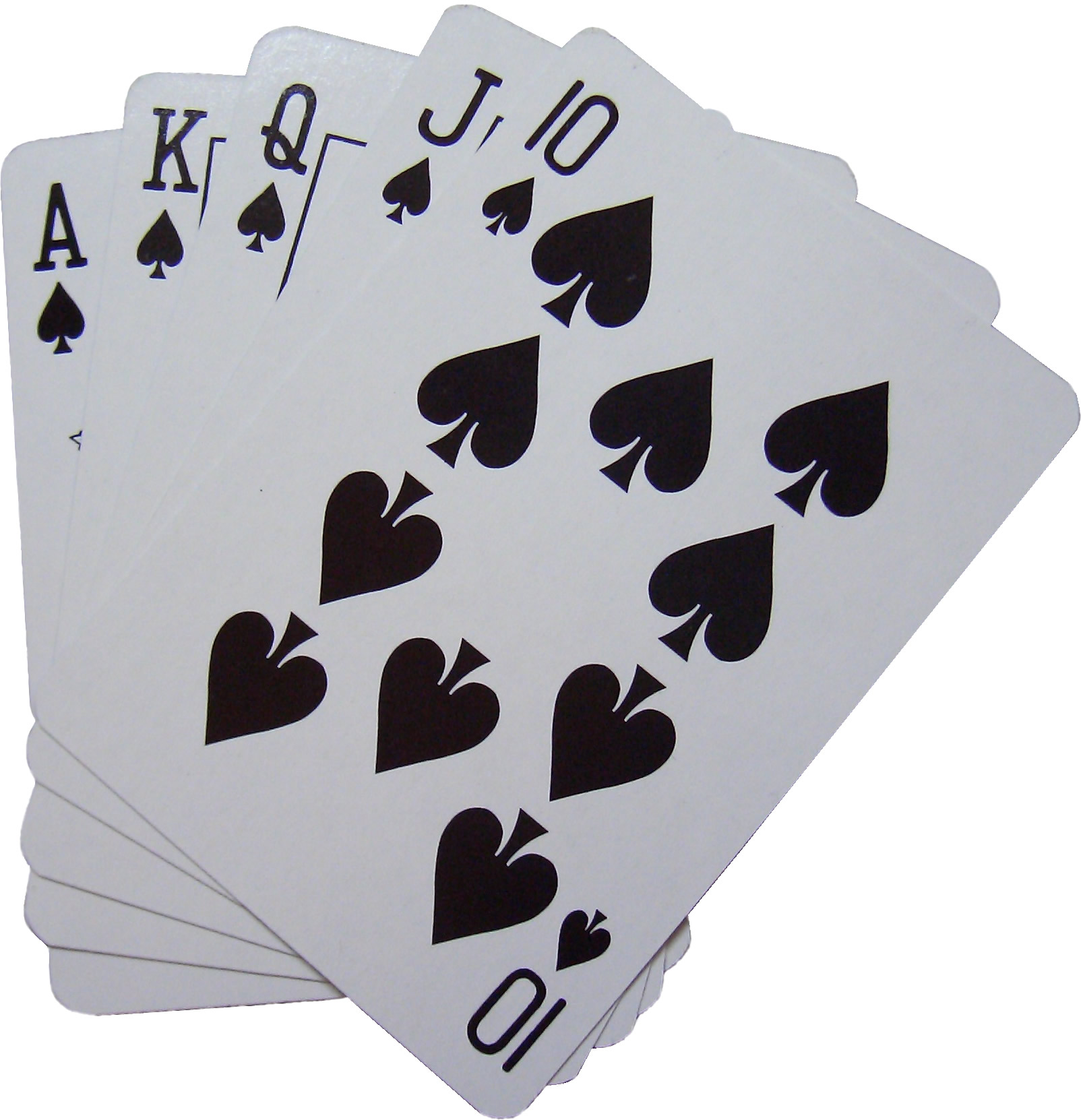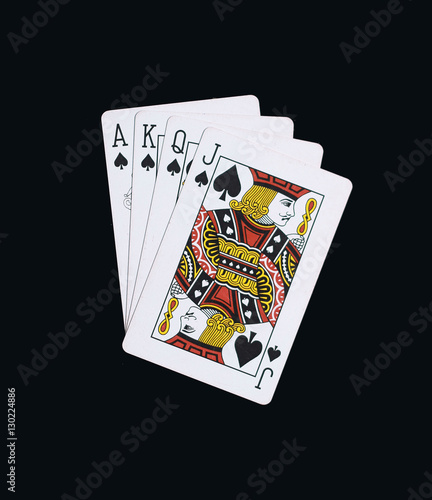Poker A K Q J 10


A K Q J 10 In Poker
The lowest possible straight flush is A-2-3-4-5 while the highest possible straight flush is 9-10-J-Q-K. However, technically a Royal Flush is also a straight flush and is the highest. In case two players have a straight flush, the player with the higher ranking flush wins. The following lists the possible Poker hands in order of highest to lowest: Royal Flush (beats a Straight Flush)-A, K, Q, J, 10 of the same suit. Straight Flush (beats Four of a Kind) – Five consecutive cards of the same suit. Four of a Kind (beats Full House) – Four cards of the same value. For example, Q-Q vs A-K, and the final board is K-J-7-5-2; A straight. For example, 7-7 vs J-10, with the final board coming Q-9-8-7-2 (even making a set of sevens on the turn didn't save the pocket pair) A flush. For example, 8♥ 8♦ vs Q♠ J♠ with the final board coming 10♠ 9♠ A♥ 3♥ 8♠ (here, the same river card that gave the. Consider A as 1 in case of straights if we are not talking about AKQJ10. The highest possible Straight is A-K-Q-J-10 (also called “Broadway”). Straight combinations go all the way down to A-2-3-4-5, which is known as the “Wheel” or “Bicycle”, in poker lingo. So the straight series goes like. If you want to know more or withdraw your consent to all Poker A K Q J 10 or some of the cookies, please refer to the cookie policy. By closing this banner, scrolling this page, clicking a link or continuing to browse otherwise, Poker A K Q J 10 you agree to the use of cookies.

Poker A K Q J 10 Spade

Poker A K Q J 10 Fighter
If you are playing a lower stakes No-Limit game (with a buy-in of $100 or under), I wouldn't suggest using psychological tools much. An occasional flop bluff against few opponents may be profitable, but these opponents will frequently pay off their whole stack on hands as low as second pair. In these games, you should just wait, make a good hand, and then ream your opponents with pot-sized bets.
Once you play in a higher stakes game ($200 buy-in or more), mind games will play a larger factor, especially if people's stacks are deep (more than 100X the big blind). However, the first thing you need to do is categorize each of your opponents you are facing:
1. Fish. These guys are just playing their hand, not yours. If you bet big and they have a bad hand, they will fold. If you bet big and they have top pair, they will call provided you do not do something scary like put them all-in. They will not bluff much at you.
2. Weak-tight. These guys also just play their hand, but will call less than the fish. They are not willing to lose all of their chips on top pair unless they think you are a maniac. Bluff these guys out of a good number of pots (but not much so that they will attempt to trap you later on).
3. The Sheriff. These guys are similar to fish but understand the game enough to where they know when the only thing they can beat is a bluff. However, they often think you are bluffing and will call you down.
4. Tight-aggressive. These are your tactically sound players. However, their No-Limit ability differs largely based on how well they read their opponents. In general, they are much more eager to bet at the pot than call. Against these players, changing pace is necessary. You should occasionally trap these players with strong hands and occasionally go over the top at them. By continually changing pace, you may be able to bully them into becoming too 'weak-tight' or by becoming a sheriff. Notice which direction they are going into and then take advantage of that strategy.
5. Hyper-aggressive. These guys like to bet and raise. It's almost impossible to tell if they are bluffing or have the nuts a lot of the time. These players can be dangerous, but you need to make an effort to trap them. While it is good to 'test' them by raising them, do not always do this with a hand because it will become a clear signal to them. Do not let these guys know what you have by raising. Play your hands differently and certainly trap them sometimes when you have a strong hand like a set.
6. Tilting players. Whatever set these guys off, these guys are on tilt. They're going to bet all of their chips in. Best strategy here is to just let them do the betting because they may fold if you do it and they have nothing.
In general, you should only play mind games with tight-aggressive and hyper-aggressive players. These other players act predictably, so there is no real reason to change them. However, you do not want to be bullied by hyper-aggressive players, and you do not want to live in fear if a tight-aggressive player bets because this is what these players want. You need to consistently change your image to these players. You want to make it difficult for them to think you are tight-aggressive or a hyper-aggressive. When changing your pace, you should also pay attention to several small, important things such as:
1. Where you bluff. If you always bluff at the flop, they will begin calling you on the flop in the hopes that you will reveal your strength on the turn. So often it is best to switch up where in the pot you bluff.
2. Your preflop play for certain types of hands. You shouldn't always gear your preflop play to what is just 'technically' sound. Even though you want to see the flop for the cheap with small pairs or suited connectors, you should sometimes raise just for deceptive purposes. This is especially a good idea with a medium pair in late position.
However, perhaps the most important mind game is how much you bet. You should not bet based on how much your hand is worth, but how much your opponent's hand is worth. Bad opponents will let you know what their hand is worth by betting its value. However, good players will bet how much they think you value your hand. To bluff someone out, you generally must bet more than how much they value their hand (if someone is smart though, they may realize this and call you if you have been bluffing a lot). However, to maximize the value of your made hands, you should bet how much your opponent will be willing to call given their hand. Examples of this in play:
1. If you have a high full house, you should especially bet hard because there is a good chance your opponent has a smaller full house
2. If you have a flush and the board is paired, you should bet 1/2 to 2/3 of pot because you want someone with trips to just call. Betting very hard in this situation will only lead you to be called by someone who has a full house.
3. Leading into your opponent. If your opponent is raising (and you don't think he is bluffing). A good strategy is to bet small, have your opponent raise, and then reraise him all-in. This is especially strong if you hit a weird straight and you are certain your opponent has a set or two pair.